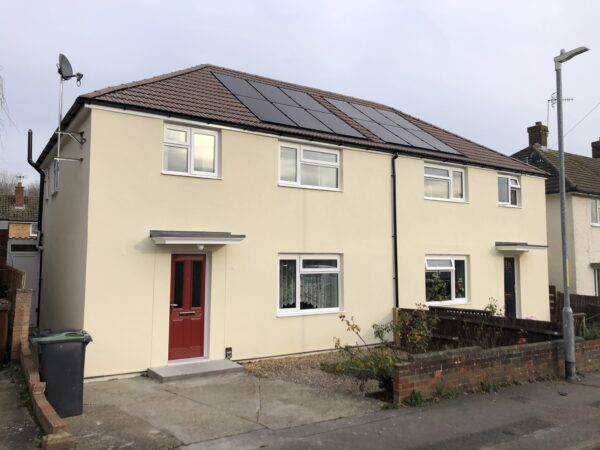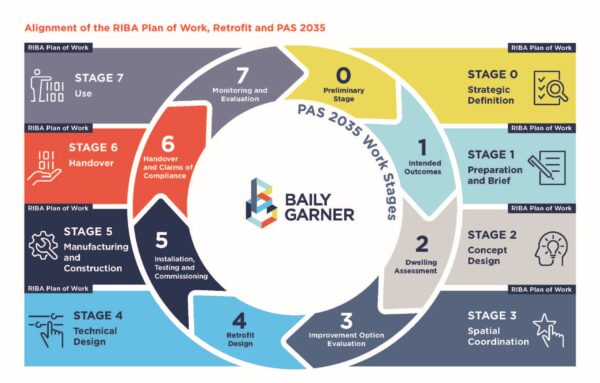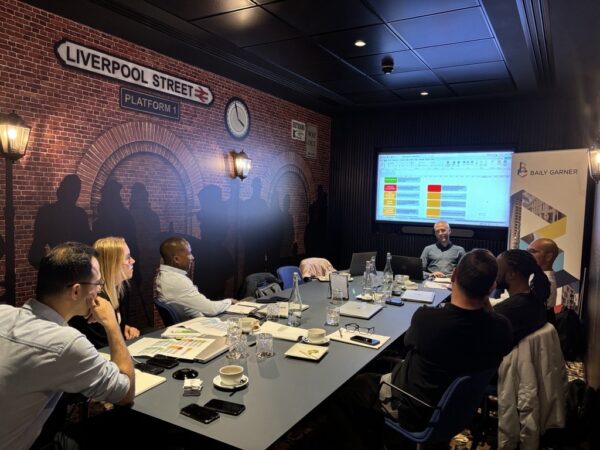Organisations across the UK are eagerly awaiting news on securing a share of the £1.29bn government fund to improve affordable housing as part of the Warm Homes: SHF Wave 3 scheme. Drawing from our extensive experience with SHDF Waves 2.1 and 2.2, hear from Associate Partner Ben Lambon-Ralph as he identifies the top 3 considerations to ensure your project’s success.
Organisations across the UK are waiting with bated breath to see if they’ve secured a chunk of the £1.29bn ringfenced by the government to improve the country’s affordable housing stock as part of the Warm Homes: SHF Wave 3 scheme.
As passionate supporters of the decarbonisation agenda, Baily Garner is keen to see each and every Wave 3 project become a success.
But, having supported the delivery of schemes since the first Social Housing Decarbonisation Fund Demonstrator through to Wave 2.2, we’re all too aware of the challenges that can jeopardise their success.
Avoiding these pitfalls will be critical for meeting the new expectations introduced for Wave 3 of a seamless delivery with regular spend year-on-year through to the delivery deadline in 2028.
Last year, we released the second volume of our Retrofit Toolkit – Unlocking Retrofit at Scale – in anticipation of more onerous expectations, discussing the lessons we learnt moving from the ‘sandbox’ of early SHDF Waves to larger-scale projects supported by Waves 2.1 and 2.2.
Download the toolkit here: Unlocking Retrofit At Scale | Baily Garner
Drawing from those discussions, here are what we believe should be your top 3 considerations in mind for Wave 3 projects.
A full and detailed analysis of properties included in your bid
It may seem obvious, but a common challenge with retrofit schemes in previous funding rounds has been inaccuracies in property data and proposed measures. This often leads to significant project change following the dwelling assessment stage – where properties are assessed, issues identified, and alternative measures proposed. As a result, substantial ‘change requests’ are made to the funding provider to re-baseline the project, creating turbulence during the delivery phase.
Organisations looking to pursue decarbonisation on the scale expected for Wave 3 will no doubt have an understanding of their housing stock and hold significant property data. However, the reliability and quality of this data needs to be tested and the delivery approach formulated.
Property archetyping and geographical analysis can be used to manage this risk and critically inform the early stages of the project. We recommend taking an 80/20 approach in favour of archetyping, which is expanded upon within our latest Retrofit Toolkit. This process categorises properties based on, among other things, their built form, construction, age and detailing. These archetypes can then be used to inform initial measure selection / prioritisation to all properties included within the project, striking a balance between accuracy and time to complete the activity. Many organisations will have undertaken this or a similar exercise to inform their bid, but for those who haven’t, it’s not too late and still a worthwhile exercise.

To maintain the 80/20 rule and ensure the number of archetypes is manageable, deviations from standard archetype classifications can be made through sub-archetypes. This means bespoke characteristics can be identified at an early stage and the implications understood.
An example of this we experienced ourselves was an archetype deviation created by a handful of properties with hanging slate cladding and porch roofs with questionable structural integrity – both presenting a technical challenge for installing external wall insulation. To remedy this, we engaged at an early stage with a specialist structural engineer and EWI provider to produce bespoke proposals. This early identification of risk significantly reduced the time and cost impact on the project.
The archetyping exercise can be combined with geographical mapping to validate existing data. Many organisations will have mapping tools available through existing asset management platforms, but alternatively these can be generated through free platforms such as Google Maps. Overlaying the archetype information, initial proposed measures and their location is a powerful method of creating a streamlined and strategic delivery approach that can maximise efficiency in later project stages.
Strong project management
One of the major lessons we’ve learnt delivering SHDF Wave 2.1 and 2.2 projects – which typically involve improvement measures to hundreds of properties – is that organisations often overlook the amount of time and effort required to manage a project, ensuring that it runs smoothly and in line with the programme.
In our experience, this lack of strong project oversight often results in schemes being led solely by the PAS 2035 standard, and while this creates a robust framework for managing effective retrofit measures with tangible outcomes, PAS 2035 is very much focused on the effective delivery of retrofit at a singular dwelling level. What it doesn’t provide (and nor should it), is a detailed methodology for delivering retrofit at scale.
As a result, properties in a programme of work are often assessed almost at random, based on factors such as access availability, and the delivery continues from here. This is not conducive of a strategic project; if we were delivering a large-scale, high-speed rail network, we would not plan to build 100m of track and install it before moving onto the next 100m. The result of this small-scale approach is problems can arise that impact both the programme and budget of a project, particularly when moving from the inspection, design and survey stage into the delivery stage.
The Royal Institute of British Architects (RIBA) have a well-known and respected process known as the RIBA Plan of Work for briefing, designing, constructing and operating building projects, which divides them into eight stages – but as of yet there is no overlay to align it with the requirements of retrofit and PAS 2035.
This is something we feel strongly about, and so we produced our own interpretation in the Toolkit, with the inclusion of additional core activities needed for large-scale projects.

Within the Toolkit, we included the critical tasks needed in the very first stages of the project, such as the creation of a retrofit strategy, archetyping studies, technical compliance documentation, resident engagement, consultation strategies and financial modelling. All of these contribute to a comprehensive, organisational approach underpinned by strong project management principles, and as Wave 3 schemes will likely include thousands of properties instead of hundreds, not installing a dedicated and experienced retrofit project manager to keep things on course could be disastrous.
A place-based approach to delivery
To create a successful project, it’s crucial to focus on archetypes with well-understood measures and predictable outcomes, rather than simply aiming to retrofit a certain number of properties. Even better if the project outcomes closely align to the organisation’s asset management strategy. By starting with these archetypes, organisations can ensure measures are effective and appropriate, allowing for a controlled and predictable rollout while reducing the risk of unforeseen issues that could delay the project.
When it comes to delivery, the ideal programme will group properties according to both geography and archetype, curating a strategy that enhances resident engagement by focusing on the improvements made to homes in a specific area, while also targeting the low-hanging fruit for quick wins. This place-based approach requires collaboration and engagement with a whole range of stakeholders to take account of each place’s unique blend of characteristics and offers the opportunity to explore avenues for enhancing biodiversity, nature and water management, ecology, and social and community value.
When residents see their entire community is being considered, they are more likely to be supportive and cooperative, and this is vital for the success of the project, as it can lead to smoother implementation and higher satisfaction rates.
A place-based approach will inevitably mean each location will include properties with a range of improvement measures that vary in complexity, and so their implementation will be evenly spread throughout each year, rather than those with a high risk of delaying the programme all occurring at once. This even delivery model will also align the project with the Wave 3 rules for drawing down funding, meaning the work can be spread out in a way that matches the funding schedule of 33.3% each year until 2028, preventing cash flow issues and ensuring resources are available when needed.
This will create a desirable project and the approach will be welcomed by installers and contracting organisations – who will be in high demand as the announcement is made.
By balancing the delivery model with the funding requirements, organisations can maintain steady progress and avoid the pitfalls of overcommitting or underdelivering at different stages of the project.
How can we help?
Our retrofit and sustainability team leads the market in our knowledge of property archetypes and the PAS 2035 standard, as well as modelling improvement measures and validating them with tangible outcome data.
With backgrounds in building surveying and project management, we’re able to instil strong oversight alongside providing the PAS 2035 roles so that each property is evaluated holistically and risks are managed proactively so they don’t delay the programme.

We’ve put these skills into practice on some of the most ambitious retrofit schemes in the country, including the two largest successful SHDF 2.1 bids: Birmingham City Council and Clarion Housing Association.
We’ve also been providing support to bidders throughout their retrofit journey alongside Turner and Townsend through the Social Housing Retrofit Accelerator (SHRA), funded by the Department for Energy Security and Net Zero. This free advice service was rebranded as Retrofit Information Support and Expertise (RISE) with the introduction of Warm Homes: SHF Wave 3, but we’ve continued in our advisory role.
With a base of operations in London, Birmingham and Manchester, we’re able to offer our services nationally.
Please contact one of the below partners to learn more about how we can help you on your retrofit and sustainability journey:
Ben Lambon-Ralph – South Retrofit Lead
Lucy Mullineux – Midlands Retrofit Lead
Tom Cadman – North Retrofit Lead
Dan Bridgewater – Design
Adam Pannell – Cost



